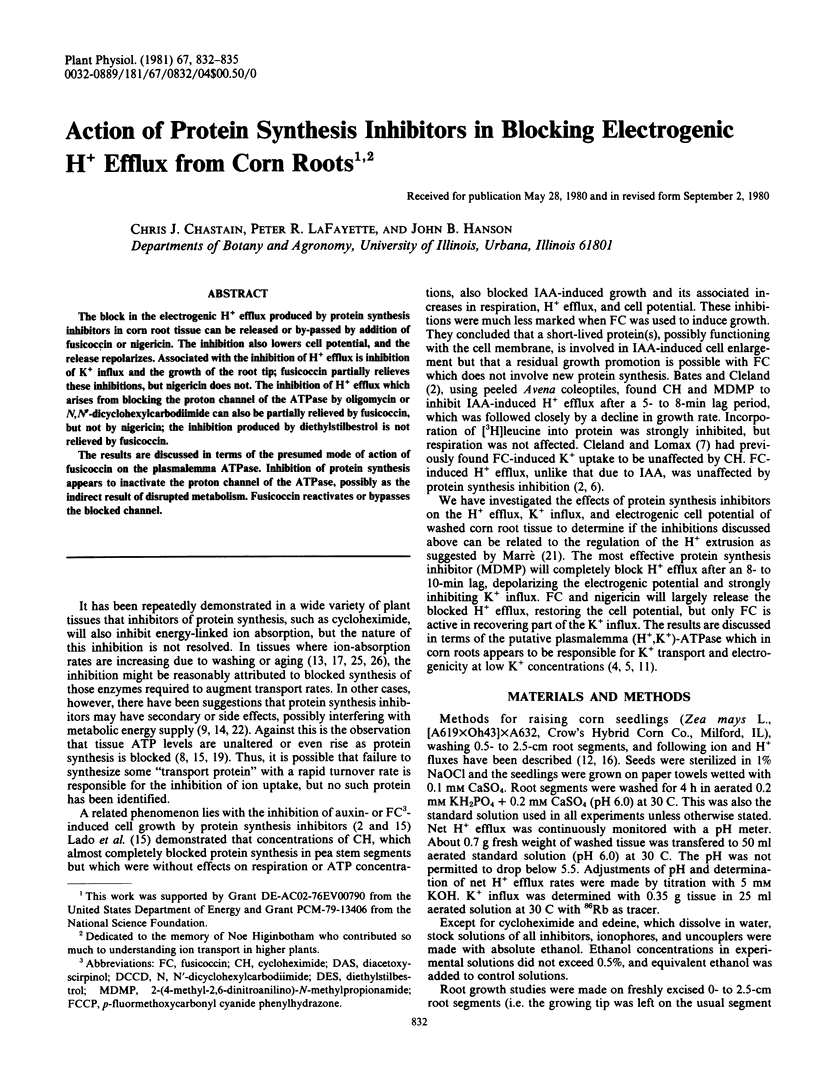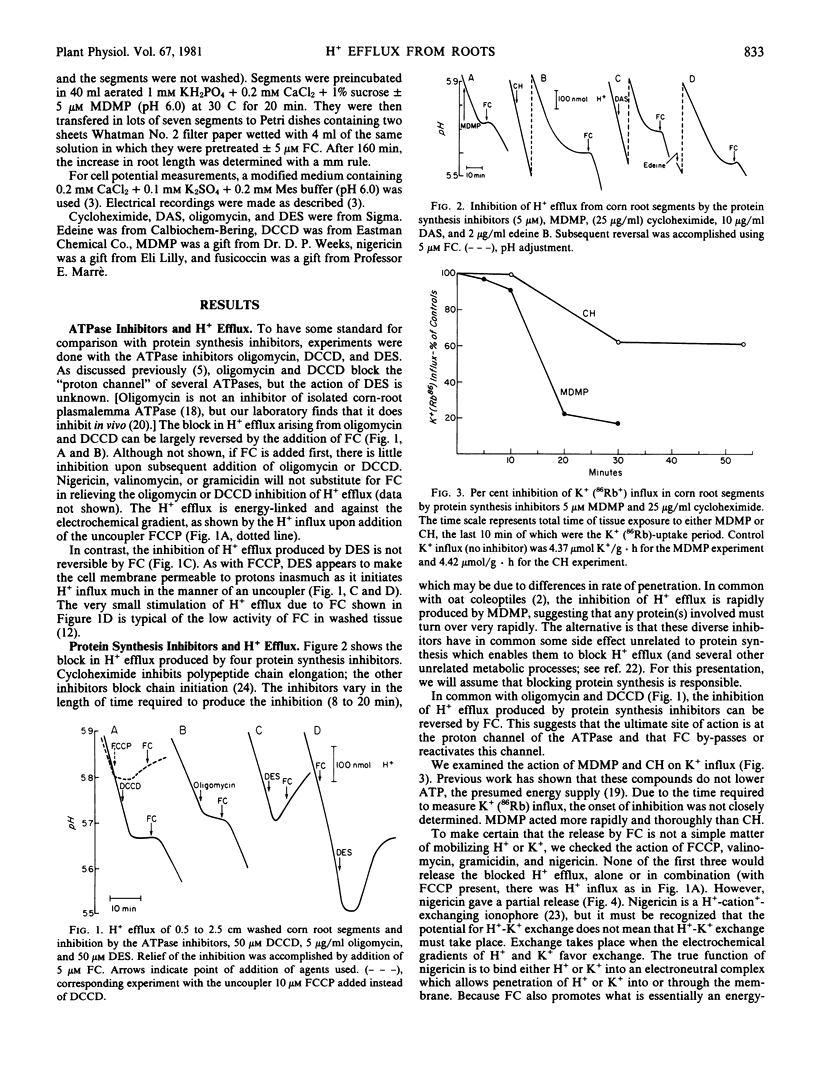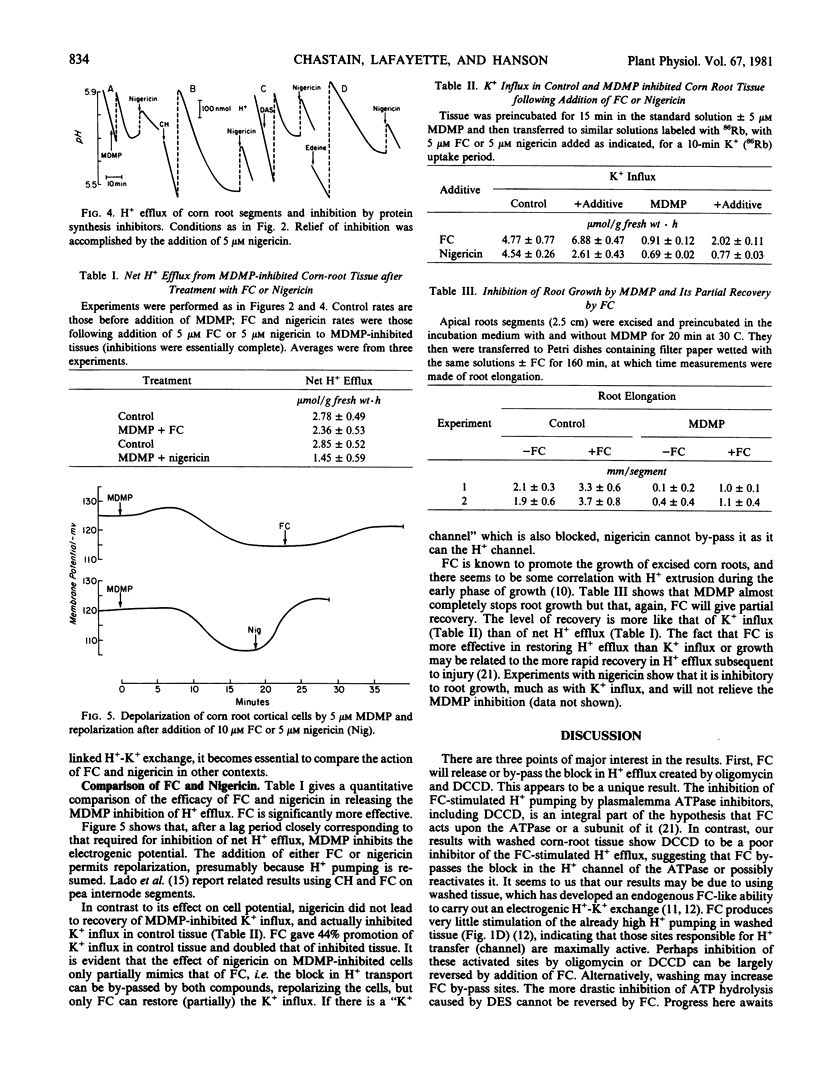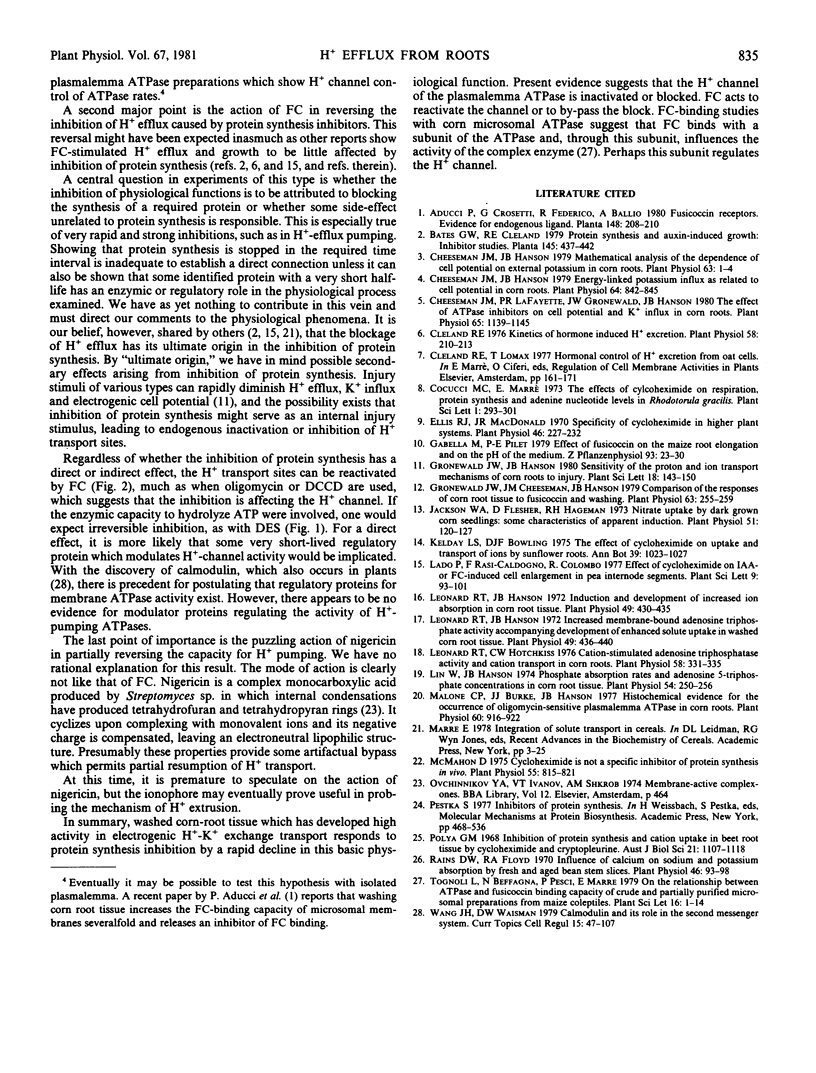Abstract
The block in the electrogenic H+ efflux produced by protein synthesis inhibitors in corn root tissue can be released or by-passed by addition of fusicoccin or nigericin. The inhibition also lowers cell potential, and the release repolarizes. Associated with the inhibition of H+ efflux is inhibition of K+ influx and the growth of the root tip; fusicoccin partially relieves these inhibitions, but nigericin does not. The inhibition of H+ efflux which arises from blocking the proton channel of the ATPase by oligomycin or N,N′-dicyclohexylcarbodiimide can also be partially relieved by fusicoccin, but not by nigericin; the inhibition produced by diethylstilbestrol is not relieved by fusicoccin.
The results are discussed in terms of the presumed mode of action of fusicoccin on the plasmalemma ATPase. Inhibition of protein synthesis appears to inactivate the proton channel of the ATPase, possibly as the indirect result of disrupted metabolism. Fusicoccin reactivates or bypasses the blocked channel.
Full text
PDF



Selected References
These references are in PubMed. This may not be the complete list of references from this article.
- Cheeseman J. M., Hanson J. B. Energy-linked Potassium Influx as Related to Cell Potential in Corn Roots. Plant Physiol. 1979 Nov;64(5):842–845. doi: 10.1104/pp.64.5.842. [DOI] [PMC free article] [PubMed] [Google Scholar]
- Cheeseman J. M., Hanson J. B. Mathematical analysis of the dependence of cell potential on external potassium in corn roots. Plant Physiol. 1979 Jan;63(1):1–4. doi: 10.1104/pp.63.1.1. [DOI] [PMC free article] [PubMed] [Google Scholar]
- Cheeseman J. M., Lafayette P. R., Gronewald J. W., Hanson J. B. Effect of ATPase inhibitors on cell potential and k influx in corn roots. Plant Physiol. 1980 Jun;65(6):1139–1145. doi: 10.1104/pp.65.6.1139. [DOI] [PMC free article] [PubMed] [Google Scholar]
- Cleland R. E. Kinetics of Hormone-induced H Excretion. Plant Physiol. 1976 Aug;58(2):210–213. doi: 10.1104/pp.58.2.210. [DOI] [PMC free article] [PubMed] [Google Scholar]
- Ellis R. J., Macdonald I. R. Specificity of cycloheximide in higher plant systems. Plant Physiol. 1970 Aug;46(2):227–232. doi: 10.1104/pp.46.2.227. [DOI] [PMC free article] [PubMed] [Google Scholar]
- Gronewald J. W., Cheeseman J. M., Hanson J. B. Comparison of the responses of corn root tissue to fusicoccin and washing. Plant Physiol. 1979 Feb;63(2):255–259. doi: 10.1104/pp.63.2.255. [DOI] [PMC free article] [PubMed] [Google Scholar]
- Jackson W. A., Flesher D., Hageman R. H. Nitrate Uptake by Dark-grown Corn Seedlings: Some Characteristics of Apparent Induction. Plant Physiol. 1973 Jan;51(1):120–127. doi: 10.1104/pp.51.1.120. [DOI] [PMC free article] [PubMed] [Google Scholar]
- Leonard R. T., Hanson J. B. Increased Membrane-bound Adenosine Triphosphatase Activity Accompanying Development of Enhanced Solute Uptake in Washed Corn Root Tissue. Plant Physiol. 1972 Mar;49(3):436–440. doi: 10.1104/pp.49.3.436. [DOI] [PMC free article] [PubMed] [Google Scholar]
- Leonard R. T., Hanson J. B. Induction and development of increased ion absorption in corn root tissue. Plant Physiol. 1972 Mar;49(3):430–435. doi: 10.1104/pp.49.3.430. [DOI] [PMC free article] [PubMed] [Google Scholar]
- Leonard R. T., Hotchkiss C. W. Cation-stimulated Adenosine Triphosphatase Activity and Cation Transport in Corn Roots. Plant Physiol. 1976 Sep;58(3):331–335. doi: 10.1104/pp.58.3.331. [DOI] [PMC free article] [PubMed] [Google Scholar]
- Lin W., Hanson J. B. Phosphate absorption rates and adenosine 5'-triphosphate concentrations in corn root tissue. Plant Physiol. 1974 Sep;54(3):250–256. doi: 10.1104/pp.54.3.250. [DOI] [PMC free article] [PubMed] [Google Scholar]
- Malone C. P., Burke J. J., Hanson J. B. Histochemical Evidence for the Occurrence of Oligomycin-sensitive Plasmalemma ATPase in Corn Roots. Plant Physiol. 1977 Dec;60(6):916–922. doi: 10.1104/pp.60.6.916. [DOI] [PMC free article] [PubMed] [Google Scholar]
- McMahon D. Cycloheximide is not a specific inhibitor of protein synthesis in vivo. Plant Physiol. 1975 May;55(5):815–821. doi: 10.1104/pp.55.5.815. [DOI] [PMC free article] [PubMed] [Google Scholar]
- Rains D. W., Floyd R. A. Influence of calcium on sodium and potassium absorption by fresh and aged bean stem slices. Plant Physiol. 1970 Jul;46(1):93–98. doi: 10.1104/pp.46.1.93. [DOI] [PMC free article] [PubMed] [Google Scholar]
- Wang J. H., Waisman D. M. Calmodulin and its role in the second-messenger system. Curr Top Cell Regul. 1979;15:47–107. doi: 10.1016/b978-0-12-152815-7.50006-5. [DOI] [PubMed] [Google Scholar]


